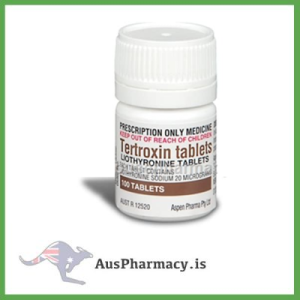T3 Tertroxin liothyronine sodium – 100 Tablets x 20mcg
T3 Tertroxin (Liothyronine Sodium) represents the active thyroid hormone triiodothyronine (T3) — a vital compound for studying endocrine physiology, metabolism, and molecular regulation.
In educational and pharmaceutical sciences, it provides an essential framework for understanding hormone biosynthesis, receptor mechanisms, and metabolic rate regulation.
This academic overview explains T3’s biochemical role, structure, and importance in endocrine and pharmacological education.
2. Chemical and Pharmacological Profile
-
Chemical Name: Liothyronine Sodium (T3)
-
Molecular Formula: C15H11I3NNaO4
-
Molecular Weight: 672.96 g/mol
-
Class: Thyroid hormone analogue
-
Origin: Synthetic form of naturally occurring triiodothyronine (T3)
T3 is derived from iodinated tyrosine residues within thyroglobulin, forming the active hormone responsible for stimulating metabolic activity at the cellular level.
3. Physiological Role and Function
T3 (Liothyronine) is the biologically active form of thyroid hormone, responsible for most metabolic and physiological effects in the body.
Key educational concepts include:
-
Regulation of basal metabolic rate (BMR)
-
Stimulation of protein and lipid metabolism
-
Enhancement of oxygen consumption and thermogenesis
-
Influence on cardiac output and neural development
In the endocrine system, T3 acts on nuclear receptors, altering gene expression that controls energy production and tissue growth.
4. Mechanism of Action
T3 binds to thyroid hormone receptors (TRα and TRβ) located in the cell nucleus.
This receptor–ligand interaction leads to:
-
DNA binding at thyroid response elements (TREs)
-
Regulation of transcription of genes controlling metabolism
-
Protein synthesis modulation for energy and growth
This mechanism is a cornerstone topic in molecular pharmacology and endocrinology education, illustrating ligand–receptor interactions and gene regulation.
5. Educational Importance
T3 Tertroxin is central to the academic study of:
-
Endocrine feedback systems (HPT axis)
-
Molecular signaling and gene expression
-
Enzyme activation and metabolic rate control
-
Pharmacokinetics of hormone analogues
Students in biomedical, pharmaceutical, and physiological sciences use it as a model to explore hormone regulation and systemic metabolism.
6. Chemical Structure and Comparison with T4
T3 differs from T4 (Thyroxine) by having three iodine atoms instead of four, which greatly increases its metabolic potency.
| Parameter | T3 (Liothyronine) | T4 (Thyroxine) |
|---|---|---|
| Iodine Atoms | 3 | 4 |
| Potency | 3–5x stronger | Precursor hormone |
| Half-life | ~1 day | ~7 days |
| Biological Role | Active hormone | Storage/prohormone |
This comparison demonstrates how small chemical variations can lead to significant functional differences, a vital lesson in pharmaceutical chemistry.
7. Endocrine Feedback Mechanism
T3 is part of the hypothalamic–pituitary–thyroid (HPT) axis, illustrating negative feedback regulation.
-
The hypothalamus releases TRH (Thyrotropin-Releasing Hormone).
-
The pituitary gland secretes TSH (Thyroid-Stimulating Hormone).
-
The thyroid gland produces T4 and T3.
-
Rising levels of T3 and T4 inhibit TRH and TSH release.
Students studying endocrinology use this model to understand homeostatic control and hormonal feedback systems.
8. Pharmacokinetics (Educational Overview)
Liothyronine demonstrates key pharmacokinetic principles:
-
Absorption: Rapid oral absorption (~95%)
-
Distribution: Extensive protein binding to thyroxine-binding globulin and albumin
-
Metabolism: Hepatic and peripheral deiodination
-
Half-life: 1–2 days
-
Excretion: Renal and biliary pathways
These parameters make it an excellent compound for teaching ADME (Absorption, Distribution, Metabolism, Excretion) concepts in pharmaceutical studies.
9. Laboratory and Research Applications
In academic research, T3 is used to:
-
Demonstrate metabolic stimulation in cell cultures
-
Study gene transcription related to energy metabolism
-
Model hormone–receptor interactions
-
Explore feedback mechanisms in endocrine physiology
These experiments help connect molecular biology to physiological function.
10. Molecular and Biochemical Pathways
Educational modules often use T3 to illustrate:
-
Iodination and hormone synthesis
-
Peripheral conversion from T4 to T3 by deiodinases
-
Receptor-mediated transcription control
-
Interaction with mitochondrial enzymes and metabolic genes
These pathways highlight hormone biosynthesis, enzymatic activation, and genomic regulation.
11. Structure–Activity Relationship (SAR)
Liothyronine’s structure–activity relationship emphasizes:
-
The number and position of iodine atoms affecting receptor binding affinity
-
Side-chain hydroxyl and carboxyl groups enabling strong ionic interactions
-
The importance of stereochemistry in determining bioactivity
This SAR analysis is vital in medicinal chemistry education, showing how molecular design influences biological potency.
12. Educational Relevance in Medicine and Pharmacy
T3 Tertroxin supports theoretical and practical education in:
-
Pharmacodynamics and receptor binding
-
Endocrine pharmacology
-
Biochemical pathways of metabolism
-
Comparative hormone kinetics
It serves as a teaching model to connect cellular biochemistry with systemic physiology.
13. Ethical and Academic Handling
For educational use, T3 must be handled with academic integrity and controlled supervision.
Students learn:
-
Ethical considerations in hormone research
-
Laboratory safety and documentation
-
Accurate data interpretation
-
Responsible use in academic pharmacology
This approach reinforces scientific discipline and research ethics.
14. Modern Educational Applications
Today, T3 continues to play a vital role in:
-
Molecular pharmacology simulations
-
Endocrine modeling software and lab experiments
-
Teaching feedback control and metabolic homeostasis
-
Comparative pharmacokinetics in physiology curriculums
Its biochemical versatility makes it an indispensable educational compound.
15. Conclusion
T3 Tertroxin (Liothyronine Sodium) is more than a hormone analogue — it is an essential educational and biochemical model for understanding thyroid regulation, metabolic control, and molecular pharmacology.
By studying T3’s structure, feedback mechanisms, and cellular effects, students gain insight into the delicate balance of the endocrine system and its influence on metabolism.
It remains one of the most important examples of hormonal regulation and pharmaceutical chemistry in modern education.









